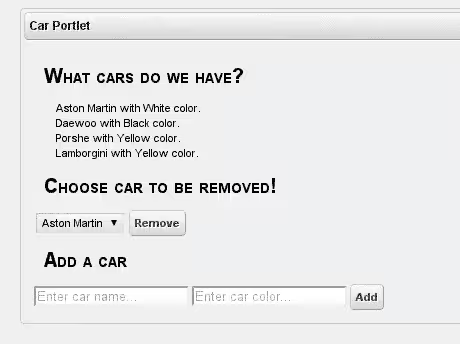Portlets are pluggable user interface software components that are managed and displayed in a web portal. They produce fragments of markup code that are aggregated into a portal. There are two specifications of portlets exist nowadays, they are JSR-168 (Java Portlet Api) and JSR-286 (Java Portlet Api 2.0).
Liferay is an opensource portal bundled with different servlet containers, such as Tomcat, Jetty, Geronimo, JBoss, etc. As it is opensource it has a reach variaty of opensource portlets for every life situation. To deploy your own one, you need Liferay portal installed. I used Liferay bundled with Tomcat of version 6.1.0 and Grails 2.0.4.
Documentation for Liferay Portal can be found at
http://www.liferay.com.
However, provided docs are not very good in my opinion.
Let’s create our own portlet for Liferay portal. You can create more than one portlet within your Grails application, what’s very good, and actually it’s very easy to implement portlets in Groovy way, so let’s keep going!
We need two great plugins installed, called portlets and portlets-liferay:
grails install-plugin portlets
grails install-plugin portlets-liferayDocumentation for these plugins also available at Grails site, to which you can refer at any time and place.
To create portlet application we need to generate portlet class which will contain specific Liferay configurations and portlet actions needed for portlet to work. This can be done by executing a Grails command:
grails create-portlet <package>.<portlet_name>Code language: HTML, XML (xml)* Note that this command will automaticaly add ‘Portlet’ keyword to the end of ‘\<portlet_name>’.
You’ve just created a portlet class, great.
Portlet.groovy file will be generated in /grails-app/portlets directory.
Here how it would look like:
import javax.portlet.*
class <portlet_name>Portlet {
def title = 'Portlet Title'
def description = '''
Description about the portlet goes here.
'''
def displayName = 'Display Name'
def supports = ['text/html':['view', 'edit', 'help']]
// DEFINITIONS FOR liferay-display.xml
def liferay_display_category = 'MyCategory'
// DEFINITIONS FOR liferay-portlets.xml
def liferay_portlet_ajaxable = 'true'
def liferay_portlet_header_portlet_css = [
'/css/protoFlow.css'
]
def liferay_portlet_header_portlet_javascript = [
'/plugins/richui-0.5/js/flow/lib/prototype.js',
'/plugins/richui-0.5/js/flow/lib/scriptaculous.js',
'/plugins/richui-0.5/js/reflection/reflection.js',
'/plugins/richui-0.5/js/flow/protoFlow.js'
]
...Code language: PHP (php)Portlets-liferay plugin for Grails reads configuration from Config.groovy and Portlet.groovy files and then generates all needed Liferay xmls and property files in grails-app/web-app/WEB-INF directory.
In your portlet class you can define title of portlet, display name, description of this portlet, header JavaScript and CSS files references, etc.
In Config.groovy file you can specify role-mapper and custom user attributes, like I did:
liferay {
portlet_role_mappers = ['administrator':'Administrator', 'guest':'Guest']
//portlet_custom_user_attributes = ['foo':'com.example.bar.Baz']
plugin_package {
name = "${appName}"
module_group_id = 'MyModule'
module_incremental_version = '1'
tags='sample'
short_description='Hey, this is a car portlet, dude!'
change_log=''
page_uri=''
author='Aleksey Lisikh'
license='Proprietary'
}
}Code language: JavaScript (javascript)Available Liferay roles can be found at “Control panel → Roles”.
Freshly generated portlet class has some demonstrating closures that render demo views, but we don’t have any views yet. Ok, let’s generate some of them:
grails generate-portlet-views <package>.<portlet_name>Code language: HTML, XML (xml)Aha, here they are, thank you Grails! “view.gsp, edit.gsp, help.gsp” would be created in directory /grails-app/views/.
After these steps your portlet can be deployed to portal. Hmm, but it’s not just what we wanted as it does nothing at the moment, so let’s add some stuff to out portlet.
I would like to create a domain class with the name Car:
grails create-domain com.sysgears.CarCode language: CSS (css)Now simply add two string fields to this class: ‘name’ and ‘color’:
class Car {
String name
String color
}Code language: JavaScript (javascript)BootStrap class can be used to fill database with values as usual:
class BootStrap {
def init = { servletContext ->
if (!Car.count) {
def cars = [['BMW', 'Black'], ['Mercedes', 'White'], ['Porshe', 'Yellow'], ['Aston Martin', 'White'], ['Daewoo', 'Gray']]
cars.each { car ->
new Car(name: car[0], color: car[1]).save(flush:true)
}
}
}
def destroy = {
}
}Code language: JavaScript (javascript)Generated portlet class has renderView and actionView actions, as you can see the second part of action’s name is ‘VIEW’, it means that these actions refer to ‘VIEW’ portlet’s mode. Also there are ‘EDIT’ and ‘HELP’ portlet modes available. More information about portlet actions available at liferay community site, please refer to it if you got some questions (and may also Google be with you).
renderView – renders view.gsp.
renderAction – makes some stuff for the VIEW mode. Let’s change these two actions, so that portlet would be able to delete car instances from database:
class CarPortlet {
def title = 'Car Portlet'
def description = '''
This is my sample grails liferay portlet.
'''
def displayName = 'Car Portlet'
def supports = ['text/html':['view', 'edit', 'help']]
def liferay_display_category = "Cars"
def liferay_portlet_header_portlet_css = [
'/css/car.css'
]
...
def actionView = {
//TODO Define action phase for 'view' portlets mode
def car = Car.get(params.id)
if (car) {
car.delete()
}
}
def renderView = {
//Return the map of the variables bound to the view,
//in this case view.gsp if it exists or render.gsp if not
def cars = Car.list()
[cars: cars]
}
...
}
Code language: PHP (php)We also need to change ‘view.gsp’ file, to meet our desires.
<%@ taglib uri="http://java.sun.com/portlet" prefix="portlet" %>
<div>
<h1 class="header">What cars do we have?</h1>
<ul>
<g:each in="${cars}" var="car">
<li>${car.name} with ${car.color} color.</li>
</g:each>
</ul>
<h1 class="header">Choose car to be removed!</h1>
<form method="post" action="${portletResponse.createActionURL()}">
<g:select name="id" from="${cars}" optionKey="id" optionValue="name"/>
<input type="submit" value="Submit"/>
</form>
</div>Code language: HTML, XML (xml)But what should you do if you wish to add your own action? Hmm… that is the question! Let’s define an action for creating cars. In our portlet class it will look like this:
...
def addCar = {
log.info('In add action. ' + params)
if (params.name && params.color) {
carService.saveCar(params.name, params.color)
}
portletResponse.setPortletMode(PortletMode.VIEW)
}
...Code language: JavaScript (javascript)By the moment of writing this article GORM didn’t work in portlet actions, and this is the known bug. The simplest way to solve this problem is creating a service class which would do GORM work. Yeah, here it is:
class CarService {
def saveCar(String name, String color) {
new Car(name: name, color: color).save(flush: true)
}
}Code language: JavaScript (javascript)OK, we solved our GORM trouble, now let’s create view for adding cars.
We need to get link to action from view, so let’s change view.gsp, it’s pretty simple:
<portlet:actionURL var="addCarURL">
<portlet:param name="action" value="addCar" />
</portlet:actionURL>
<h1 class="header">Add a car</h1>
<form method="post" action="<%= addCarURL %>">
<input placeholder="Enter car name..." name="name" />
<input placeholder="Enter car color..." name="color">
<input type="submit" value="Add" />
</form>Code language: HTML, XML (xml)” tag creates portlet’s actionURL, we need to specify a parameter which would be the name of portlet’s action. I created action ‘addCar’, so I need to specify parameter for actionURL with value of ‘addCar’. After doing this, you will be able to add cars to database.
We can invoke our newly created portlet action, but now another question is: ‘How can we render our own views?’ Well, it is not much different from mapping to portlet action, you simply have to define portlet tag in gsp.
When car is added I want my application to show a message that car was added. For that case I created ‘added.gsp’ in /views/car/ directory, which looks like that:
%{--added.gsp--}%
<%@ taglib uri="http://java.sun.com/portlet" prefix="portlet" %>
Car was successfully added!
<portlet:actionURL var="view" portletMode="view" />
<a href="<%= view %>">Back</a>Code language: HTML, XML (xml)I wish this page to be rendered after car was added, so I need to change our ‘addCar’ closure a little:
...
def addCar = {
log.info('In add action. ' + params)
if (params.name && params.color) {
carService.saveCar(params.name, params.color)
}
portletResponse.setRenderParameter("action", "added");
}
...Code language: JavaScript (javascript)‘portletResponse.setRendererParameter’ will invoke portlet’s closure named ‘renderAdded’ which I left empty, as it’s not necessary to get any model for that view:
def renderAdded = {
log.info('Rendering added car view.')
}Code language: JavaScript (javascript)Also If you wish to render custom gsp view file, you can do it by creating a link to action which renders gsp page:
<%@ taglib uri="http://java.sun.com/portlet" prefix="portlet" %>
<portlet:renderURL var="added">
<portlet:param name="action" value="added"/>
</portlet:renderURL>
<a href="<%= added %>">Go to page</a>Code language: HTML, XML (xml)By clicking on “Go to page” renderAdded will be invoked, and that action renders ‘added.gsp’. Just what we needed! 🙂
And this is it! Now let’s see what we’ve got:
- Create war file, using Grails command:
grails war - Then just copy freshly created war file to %LIFERAY_HOME%/deploy directory. Liferay will deploy your portlet application, and it would be available for use.
- Add portlet to the page. Login as Bruno admin (or another credentials with admin rights), then in control panel go to Add → More → (in our case it’s named ‘Cars’) and simply drag and drop ” (which is ‘Car Portlet’ for me) to the page.
Here’s a screenshot:

GitHub:
repo link
Hope, this will be helpful. Cheers!

